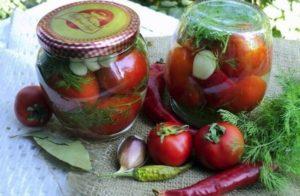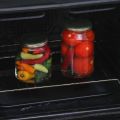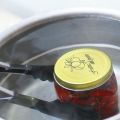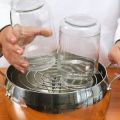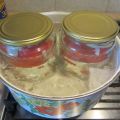10 ways to properly sterilize jars at home
Both cucumbers and tomatoes are rolled up in glass containers for long-term storage. It washes well, but beats on impact, bursts when filled with hot water. Women who canned vegetables decide on their own how the jars are best sterilized so that the glass does not crack and the workpieces do not deteriorate for a long time. There are several ways to heat cookware, each of them has its own nuances.
Content
- 1 Why do you need to sterilize canning jars?
- 2 Do I have to do this?
- 3 Preparing cans before starting the process
- 4 Ways to sterilize cans at home
- 5 How to sterilize cans with blanks?
- 6 Sterilization temperature and time
- 7 Why wrap cans of blanks?
- 8 Why do jars burst during sterilization?
- 9 Storage of sterilized containers
Why do you need to sterilize canning jars?
Even with careful washing of dishes, not all fungi and bacteria die. Remaining in closed jars, microorganisms begin to multiply. The brine becomes cloudy, mold appears on the surface. Containers and lids are sterilized to kill germs, extend the shelf life of fruit compotes and preserves, canned vegetables. Regardless of the chosen method of heat treatment, open cans are washed not with chemicals, but with mustard powder or soda.
Do I have to do this?
Sterilization of containers takes a lot of time, but it allows you to destroy all microorganisms, to increase the shelf life of the workpieces. You can replace boiling in hot water by thoroughly washing the jars, heating them in the oven or over steam. Some housewives fill a clean container with canned vegetables twice or three times with boiling water, then pour it with brine or marinade, after rolling it upside down and wrap it up with dense material.
Preparing cans before starting the process
Glass is fragile, so each container should be checked for cracks or chips. It is undesirable to use covers that have already been rolled up, even if they are flat and not rusty. Banks need to be washed with soda, mustard. Chemical products such as Fairy are not suitable for this purpose, since they are not completely rinsed out, you can use laundry soap that does not contain synthetic additives and fragrances.
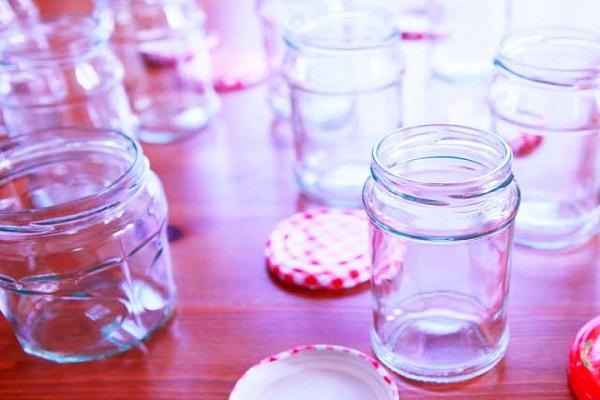
Ways to sterilize cans at home
Both empty containers and containers filled with vegetables, mushrooms or fruits are heated. In both cases, there are certain rules for sterilization, and the method depends on the choice of a household device. The cans are heated with steam, in an airfryer, in a microwave oven and even in a dishwasher.
In the oven
Before sterilization, the washed containers are dried on a towel.If a large amount of food is canned, empty jars with lids without rubber bands are placed in the oven. When the temperature rises to 200 ° C, the dishes are heated for 10 minutes, turned off, and taken out not immediately, but after cooling. The glass will not crack and the germs will die. The simple method of sterilization is convenient because more than one can can be heated on the wire rack, but several. The rubber bands are dipped in boiling water.
In electric
The oven is not turned on in advance. The wet container is placed upside down, the dry container is placed on the neck, and lids are placed next to it for seaming conservation. In an electric oven, it is enough to set the temperature to 150 ° C and sterilize the 3-liter jars - 20 minutes, 0.5 - 10. Remove the dishes, when they cool down, cover with a towel.
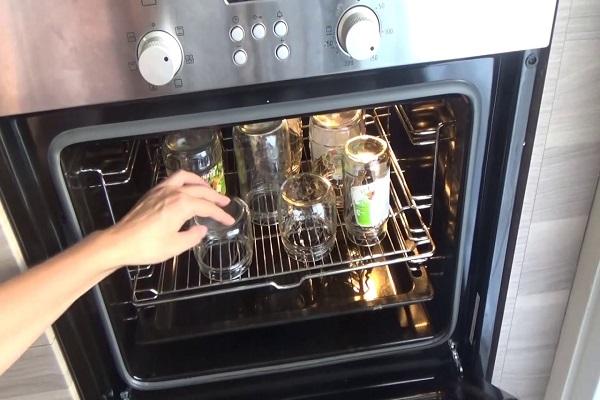
In the gas
Containers heated in such an oven do not form a concentrate on the walls, do not crack, and the workpieces in it do not deteriorate for a long time, retain their freshness and aroma. Sterilization includes several stages:
- Banks without chips and cracks are washed in hot water with soda and rinsed in cool.
- Place on a wire rack with the neck down.
- Turn on the oven, gradually increasing the temperature to 150–160 ° С.
- At the maximum parameter, small containers warm up for a quarter of an hour, three-liter containers - from 25 to 20 minutes.
In order not to get burned, they take out the hot container, putting on mittens. Placed on a towel upside down.
In the microwave
You can quickly sterilize glassware by sending it to a powerful microwave oven. How many containers will fit depends on the volume of the device, in order to do everything right:
- Water is poured into the cans so that the bottom is covered by 20 mm.
- Send the container to the microwave for 5 minutes.
- Remove with an oven mitt and dry on a towel.
In order not to break the tightness of the microwave oven, the metal lids in it are not disinfected, but you can warm them up in a regular oven.
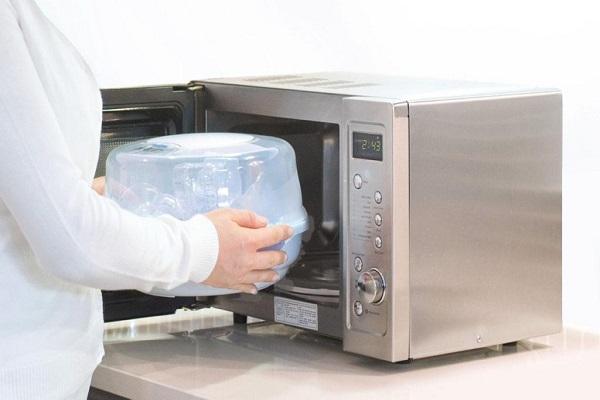
In a pot of boiling water
Despite the emergence of modern household devices, many women sterilize containers, as grandmothers did. Jars and lids are washed with mustard or soda and placed in a large saucepan or bucket filled with water so that it reaches the neck. Small containers are boiled on the stove for 6 or 7 minutes; it will take half an hour to sterilize 3-liter cans. To prevent the glass from breaking, cover the bottom of the pan with a towel in advance.
Over the ferry
Bacteria and fungi die not only in boiling water, destroys pathogenic microorganisms, disinfects containers with hot steam. The pan is filled with water, the washed, dried glass container is placed on a sieve or wire rack so that the neck remains at the bottom. Three-liter containers are kept over steam for half an hour, then removed and transferred to the other side on a towel.
Over the teapot
In a large saucepan, the water boils for a long time. To speed up the sterilization process, empty small jars are placed in the opening of the kettle, put it on the stove.
Disinfect glass containers for vegetable preparations until drops of water form on the inner walls. A liter container in a teapot is sterilized for 10 minutes.
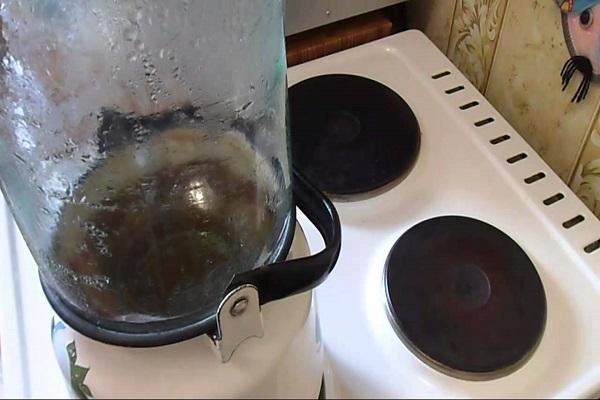
In a double boiler
Banks without cracks and chips are washed in advance with soda, the lids are thoroughly cleaned with a brush and heated in a water bath, sending for this to a double boiler. After boiling the liquid, the container is sterilized for a quarter of an hour, removed from the bowl with a dry cloth or gloves and put on a towel with the neck down.
In a multicooker
Before rolling up a salad or preserving vegetables, you need to prepare and sanitize the jars where the snacks will be stored. Women who have a multicooker in the kitchen:
- Pour 2 or 3 glasses of water into a bowl.
- Placed on the bottom of the lid.
- A basket is installed, a glass container is placed on it.
- Select the mode and boiling time.
It is easier to sterilize small jars this way. Cool and dry them on a towel.
Dishwasher safe
It is not necessary to rub the container for the blanks with soda or mustard powder if you use household appliances for disinfection, in which a sterilization mode is provided. Glass jars with lids are simply loaded into the dishwasher, but no powder is added.
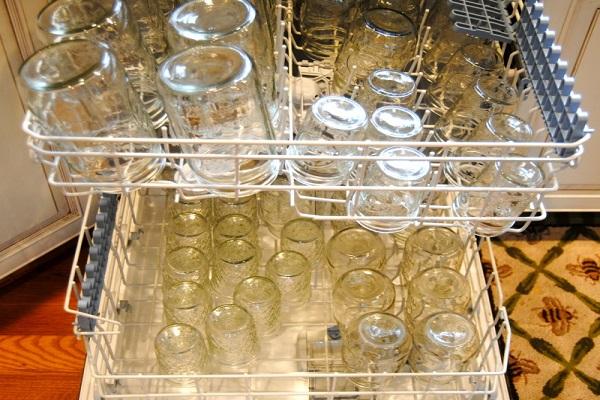
In the airfryer
Hot air is no worse than steam or boiling water, it copes with bacteria and fungi. An aerogrill is used to disinfect dishes into which canned vegetables, caviar or salad are placed.
The device is freed from unnecessary gratings, clean cans are placed in it. Choose a mode with a temperature of at least 150 ° C. The containers are taken out after a quarter of an hour, filled with preservation, tightened with lids, which are boiled separately in water.
How to sterilize cans with blanks?
To keep canned tomatoes, pickled and baked eggplants, vegetable salads longer, they are transferred to clean and dry glass jars, which are covered, placed on a baking sheet in the oven and sterilized. Heat the containers slowly to 100 or 120 ° C, disinfect for as many minutes as indicated in the recipe.
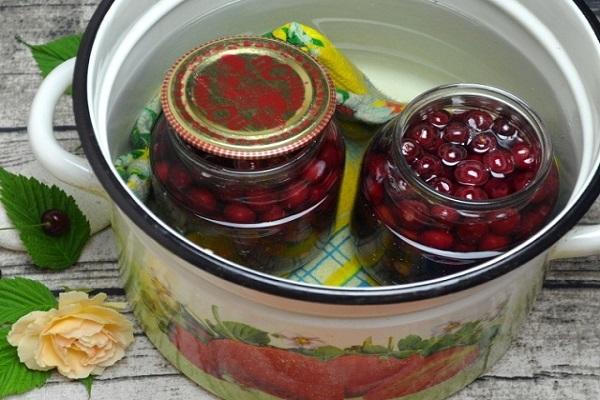
Sterilization temperature and time
Containers are disinfected in different ways. If you use a gas or electric oven, cans of 0.5, 0.75 liters at a temperature of 150-180 ° C are sterilized for only 10 minutes, the same amount - over steam and in a saucepan with boiling water.
It will take a long time to disinfect a container with a volume of three liters, it takes at least half an hour to warm up.
Why wrap cans of blanks?
Sometimes, when preserving, cucumbers or tomatoes are poured twice or three times with water, vinegar is added, but they are not put immediately in the pantry, they are not taken to the basement, but wrapped in a blanket, blanket or thick towel. In hot brine or marinade, vegetables are sterilized, and not only steamed, which increases the shelf life of snacks, containers with such conservation practically do not explode.
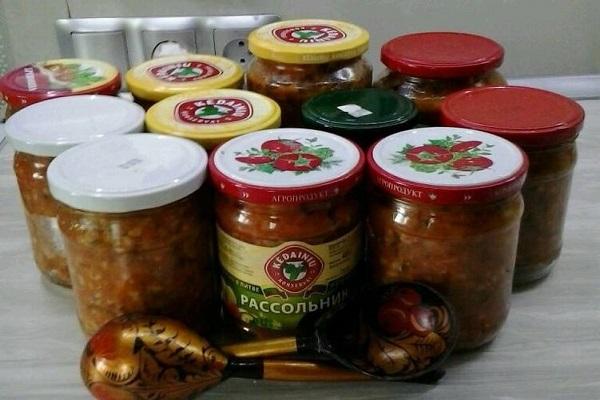
Why do jars burst during sterilization?
Glass is a fragile material that can crack from a minor impact, from temperature changes. If you wash and rinse the jars with cold water, they burst in boiling water. Glassware explodes when removed from a hot oven in a cool room.
Storage of sterilized containers
Heat, boiling water and steam destroy microorganisms. Bacteria and fungi die in a microwave, in a dishwasher, and in an airfryer, but as the cans cool down, sterility decreases. It is recommended to disinfect containers for workpieces immediately before preservation, and not for future use.

